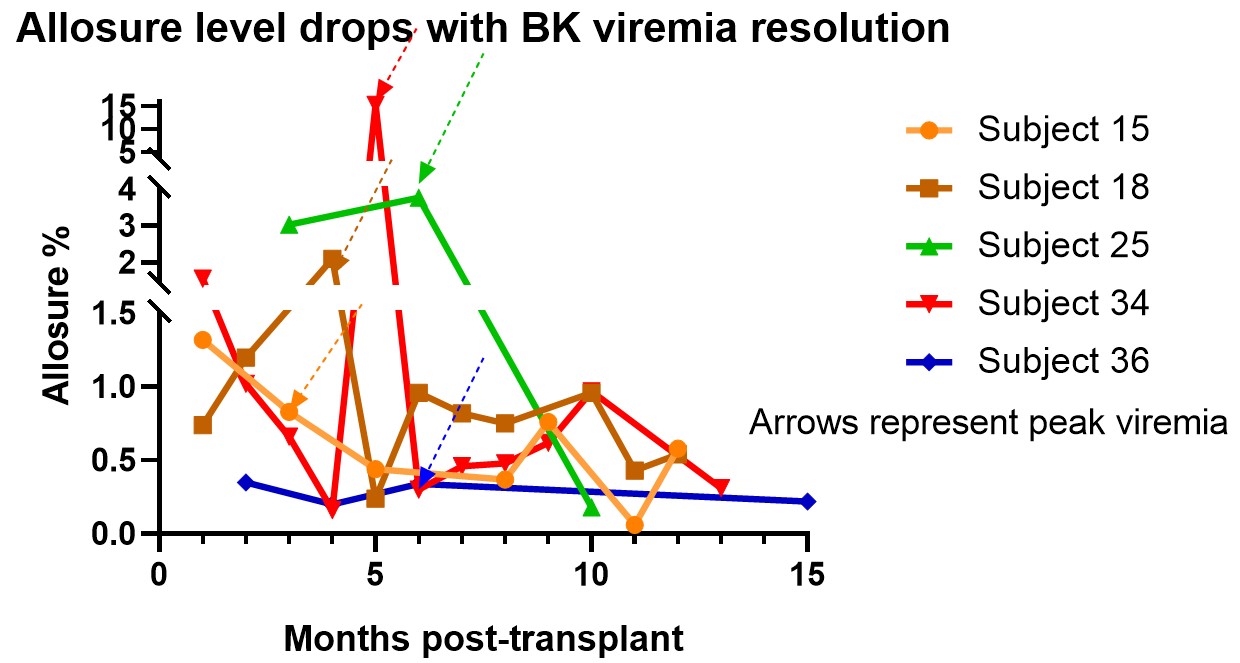Longitudinal Studies of Blood Donor-derived Cell Free DNA (dd-cfDNA) Show Predictable Rise at Time of BK Viremia or Viruria in Pediatric Kidney Transplant Recipients (PKTx)
1Washington University in St Louis, St. Louis, MO, 2CareDx, Brisbane, CA
Meeting: 2021 American Transplant Congress
Abstract number: 1006
Keywords: Infection, Kidney transplantation, Pediatric, Rejection
Topic: Clinical Science » Kidney » Kidney: Pediatrics
Session Information
Session Name: Kidney: Pediatrics
Session Type: Poster Abstract
Session Date & Time: None. Available on demand.
Location: Virtual
*Purpose: Blood levels of dd-cfDNA elevate in various forms of kidney transplant injury, most notably used for detecting potential acute rejection. A few adult studies, largely cross-sectional, have described elevations at time of other injuries such as ischemic or infections (bacterial or polyoma BK virus). We hypothesized that dd-cfDNA had a discriminating role between BK Viruria and Viremia and can act as a surrogate marker to quantify the severity of viral injury for both diagnosis and management.
*Methods: We have performed longitudinal biobanking of plasma and urine in our PKTx population since 2013, combined with monthly testing for urine BK virus DNA by PCR (switch to blood once urine is positive) from months 1-12 post-transplant. In this study we assayed longitudinal biobanked and prospective plasma samples for dd-cfDNA levels (Allosure; CareDx) and associated to standard of care longtitudinal BK viremia or viruria results, positive defined as any detectable DNA. Statistical analyses were performed via SAS using least squares means mixed modeling.
*Results: In 257 urine and 257 plasma samples from 56 children (Males 57.1%, white 76.7%, deceased donor 67.8%), subjects with BK viruria within the first 12 months (sample n = 71/257 or 28%) showed a simultaneous higher plasma dd-cfDNA load (mean 0.77% versus 0.49%). Subjects with BK viremia within the first 12 months (sample n = 23/257 or 9%) showed a simultaneous higher plasma dd-cfDNA load (mean 1.24% versus 0.50%). By longitudinal analysis that accounted for within-subject variability, a rise of 0.80% (95% confidence intervals [CI] 0.3 to 1.28%) in dd-cfDNA levels were seen at time of BK viremia (p = 0.0014). A smaller non-significant rise of 0.32% (95% CI -0.01 to 0.66%) in dd-cfDNA levels were seen at time of BK viruria (p = 0.06). In 5 patients with BK viremia resolution, later dd-cfDNA levels dropped compared to levels at peak BK viremia (Figure).
*Conclusions: In our PKTx cohort, where BK infection is more common than acute rejection in the first year, the longitudinal testing suggests that any BK viremia, but not BK viruria, causes sufficient renal allograft parenchymal injury to elevate the dd-cfDNA level above a given patient’s baseline. Further, we can now quantitate the level of dd-cfDNA elevation needed to predict onset of viremia, allowing for targeted biopsies to determine BK nephropathy.
To cite this abstract in AMA style:
Dandamudi R, Gu H, Goss C, Federman S, Woodward R, Dholakia S, Walther L, Dharnidharka V. Longitudinal Studies of Blood Donor-derived Cell Free DNA (dd-cfDNA) Show Predictable Rise at Time of BK Viremia or Viruria in Pediatric Kidney Transplant Recipients (PKTx) [abstract]. Am J Transplant. 2021; 21 (suppl 3). https://atcmeetingabstracts.com/abstract/longitudinal-studies-of-blood-donor-derived-cell-free-dna-dd-cfdna-show-predictable-rise-at-time-of-bk-viremia-or-viruria-in-pediatric-kidney-transplant-recipients-pktx/. Accessed December 14, 2025.« Back to 2021 American Transplant Congress

